Accommodations

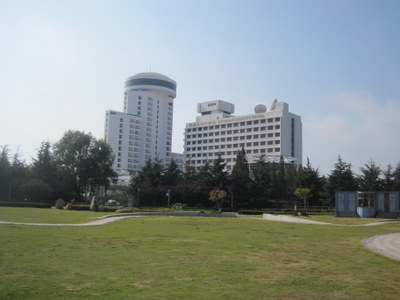 We stayed at the Huiquan Dynasty Hotel (http://www.hqdynasty.com/en/index.html), at 9 Nanhai Road in Qingdao. It's right between the No. 1 Bathing Beach (one of six numbered beaches in the city) and the Olympic plaza that tops the stadium parking structure. At the left is its main entrance, on the side facing the beach. On the right is a long shot of the whole hotel, from the Olympic plaza. It consists of a north and a south wing. Our rooms were facing the beach on the eighth floor of the south wing, which also housed the business center, indoor golf driving range, gym, mahjong rooms, "shuffleball" table, bowling lanes, hair salon, Japanese restaurant, spa, one of the pools, and (if I interpreted the sign correctly), a dentist's office.
We stayed at the Huiquan Dynasty Hotel (http://www.hqdynasty.com/en/index.html), at 9 Nanhai Road in Qingdao. It's right between the No. 1 Bathing Beach (one of six numbered beaches in the city) and the Olympic plaza that tops the stadium parking structure. At the left is its main entrance, on the side facing the beach. On the right is a long shot of the whole hotel, from the Olympic plaza. It consists of a north and a south wing. Our rooms were facing the beach on the eighth floor of the south wing, which also housed the business center, indoor golf driving range, gym, mahjong rooms, "shuffleball" table, bowling lanes, hair salon, Japanese restaurant, spa, one of the pools, and (if I interpreted the sign correctly), a dentist's office.
The revolving restaurant was at the top of the taller north wing; it served elaborate buffets three meals a day, but we only ever went up there for breakfast. That wing also housed several gift shops, the "Hawaii Bar," the other pool, and the Quingdao Specialties restaurant, where we had most of our other dinners.
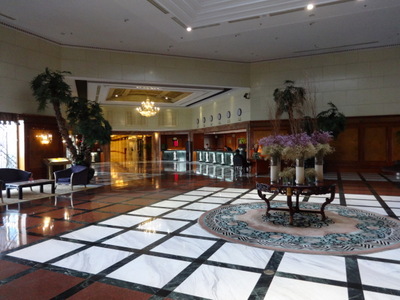
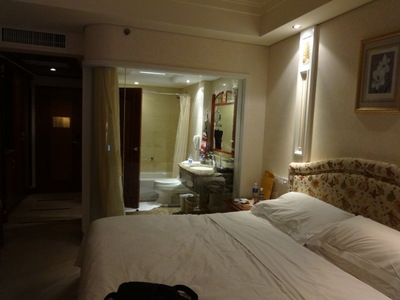 The vast lobby, shown here at the left, is between the two wings and houses, besides reception, the currency exchange, bell station, "Lobby Bar," concierge's desk, and entrances to many of the shops
The vast lobby, shown here at the left, is between the two wings and houses, besides reception, the currency exchange, bell station, "Lobby Bar," concierge's desk, and entrances to many of the shops
At the right is the view of my room, wth my back to the windows and the balcony over the beach, looking back toward the door into the hallway. As you can see, the near wall of the bathroom is glass, although a curtain can be pulled across it if you prefer less visibility (or tend otherwise to forget it's there and walk into it). Out of sight behind me are a desk and chair on one side and a stuffed armchair and hassock on the other.
The amenities of the room were numerous. In the closet were a lots of coathangers, a minisafe, two terrycloth robes (the matching slippers were in the bed-side tables), and a broad, flatiron-shaped basket for shoes (equipped with a long-handled wooden shoe horn). On a little bar next to the closet were glasses; lidded china teacups; a little basket with teabags, instant coffee envelopes, sugar (but no creamer), stirrers, etc.; and an electric tea kettle.
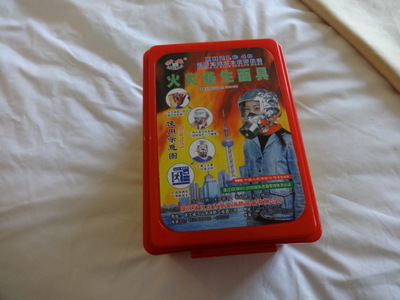
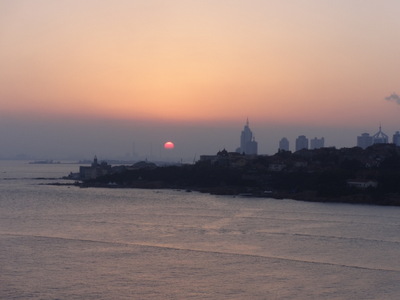 A rather hair-raising amenity, also neatly stowed in the closet, was a pair of these boxes, each a little larger than a child's lunchbox and containing a whole-head gas mask. My first thought was "Does the smog really get that bad?! How will we know if there's an alert?!" A quick scan of the multilingual instructions, though, revealed that they were for use in case of fire. Fair enough—a lot of the floors were above the reach of ladder trucks.
A rather hair-raising amenity, also neatly stowed in the closet, was a pair of these boxes, each a little larger than a child's lunchbox and containing a whole-head gas mask. My first thought was "Does the smog really get that bad?! How will we know if there's an alert?!" A quick scan of the multilingual instructions, though, revealed that they were for use in case of fire. Fair enough—a lot of the floors were above the reach of ladder trucks.
At the right is a shot from my balcony just before sunset. The air was often foggy/smoggy, but mostly foggy, I think. It didn't usually smell of smog, and in photos taken at night (when presumbly the breeze had shifted on or off shore), the distant lights of the peninsulas and passing ships were always sharp and clear.
The amenities didn't end there, though. Below the big-screen TV and DVD player was a minibar stocked with beer and soft drinks, and in the next cabinet over, a laundry basket with canvas laundry bags and laundry order forms. In the desk were hotel-letterhead stationery, envelopes, room-service breakfast order form, and brochures for local attractions, and in the center desk drawer I found scissors, a pencil, a pen, a small ruler, and half a dozen paper clips. In a bed-side table were a hair dryer, two pairs of black men's socks (still in their wrappers, with price stickers on them) and three different phone directories, but I found no Gideon Bible—it's officially an atheist country, after all. The bedside table also had a pull-out table surface to extend its area, as well as a matching, built-in rechargeable flashlight!
In the bathroom were the usual bath and hand towels and wash cloths, kleenex, a small round bar of soap (I smelled like green tea all week), a dispenser in the shower for shower gel and a whole raft of little gray cardboard boxes containing two spare toothbrushes, two combs, a sewing kit, a "lady's bag" (for sanitary disposal, I assume), a round glass bole stocked with a few cellophane-wrapped q-tips, a shoeshine cloth, a shower cap, two small tubes of body lotion, and three of what Doonesbury (for publication in family newspapers) used to call "condos," one of which had—I'm not making this up—a built-in vibrator.
When I unpacked and settled in, I stashed all that stuff (except the soap) in the drawer with the hair dryer and socks to get it out of the way, so the next day, the maid replaced it all (except the soap and the condos). At this point it wouldn't all fit in the drawer, so I piled it all in the shoe basket and set it behind the TV, where she could see that I didn't need more.
Our room keys were plastic cards, but instead of sticking them in slots, we just waved them over the door locks. Slick.
I was particularly taken with the do-not-disturb and please-make-up-the-room signs. Instead of the usual reversible paperboard dangle for the doorknob, the room had wall switches! The former was by the bed, so you didn't have to get up to post the do-no-disturb message, and the latter was by the door, so that you could punch it on your way out. They lit up little red and green signs next to your door with the relevant messages in Chinese and English. Of course, because they were on separate switches, both could be lit up at once, as they were next to the door across the hall for most of the time we were there.
The room did have some oddities. First, our bars of soap were never replaced in the course of the week. Even el-cheapo American motels confiscate your less-than-half-used soap after a couple of days and replace it with a fresh one, but here, I used that bar right down to a sliver (I hate shower gel). Second, it didn't have enough drawers. All the furniture looked as though it had drawers in it, but when you went to open them, you found that they were false fronts and were actually part of the cabinet door below. So I had any amount of tall, undivided cabinet space, mostly below countertop level, but only three shallow drawers.
A minor problem was that, when I moved in, I found a large puddle of water on the bathroom floor. I mopped it up, but it was back in the morning. A little investigation revealed that water was dripping slowly from a small, round mesh grating in the ceiling (labeled "cooma"; I don't know what it did). I put a towel under the drip, and when I went down to breakfast, I mentioned it to the concierge. He offered to move me, but I declined, explaining that it was a minor problem for me but might be a major one for the hotel. By the time I got back to the room after breakfast, two workmen were packing up their tools and folding up their ladder, and the drip was fixed. Concommitantly, the persistent sound of a cheerfully babbling brook from behind the bathroom wall had disappeared. The babbling returned intermittently during the week, but the drip never did.
The rooms' only real drawback was the heat. It was only in the 70's outside during the day, but we couldn't keep the temperature in our rooms below about 82F and very stuffy. They were supposedly air conditioned, and we tried every possible fan and temperature setting, but the AC, despite humming busily and emitting a loud whooshing sound on "hi," neither (a) cooled nor (b) moved any air. Our windows—the whole outside wall of the room—looked right into the afternoon sun, and the greenhouse effect was fierce. I tried leaving the blackout curtains closed when I left the room during the day, but the maid invariable opened them again and
looped them back (although she would leave the gauze curtains closed, that wasn't enough). The minibar also threw a lot of heat. After a couple of days, I learned that, if I opened both the door to the balcony and the door to the hallway, a stiff breeze would rush through the whole room, outward during the day, inward at night. I could blow all the hot air out when I got back to the room, then repeat the procedure a couple more times at intervals and once more just before bed. That helped a lot.
The breakfast buffet
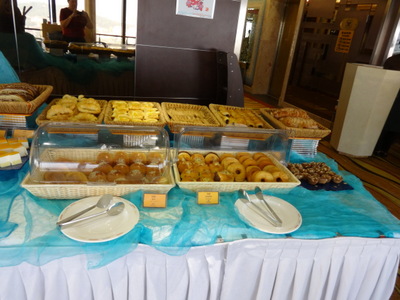
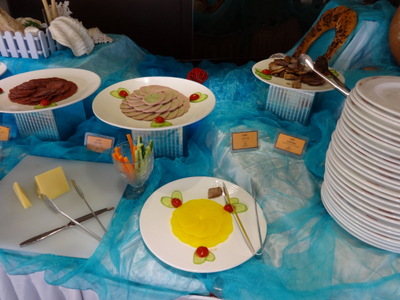 Every morning, we met at breakfast. Usually, in this situation, I get up early, eat my breakfast, and wait for David in the dining room, working on the blog. This time, though, because of the jet lag, we tended to converge on the dining room together at 6:30 a.m., when it opened.
Every morning, we met at breakfast. Usually, in this situation, I get up early, eat my breakfast, and wait for David in the dining room, working on the blog. This time, though, because of the jet lag, we tended to converge on the dining room together at 6:30 a.m., when it opened.
The selection starts, to your right as you enter, with an array of Western-style breads and pastries, including a group labeled "Danish brand" and one (consisting of house-made, unsweetened doughnuts and round sweet buns) labeled "Twinkies." Little square danishes with peach slices on them are, for some reason, labeled "mixed broccoli." Squares of mousse cake in a variety of fruit flavors that changed each day. A plate of chocolate-covered bonbons filled with something fudge-like that I never identified the flavor of.
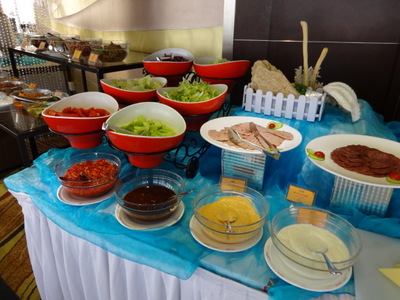
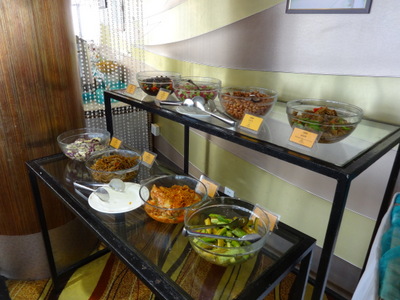 Next comes a station with plates of moist and tender smoked duck and chicken and "Russian style" pork. Salami (labeled "Italy sausage"), pepper loaf. Slices of a round sort of terrine, baloney colored around the edge but green in the center, labeled "spinach sausage." A small block of Swiss cheese.
Next comes a station with plates of moist and tender smoked duck and chicken and "Russian style" pork. Salami (labeled "Italy sausage"), pepper loaf. Slices of a round sort of terrine, baloney colored around the edge but green in the center, labeled "spinach sausage." A small block of Swiss cheese.
Then bowls of salad greens, cherry tomatoes, cucumber slices, shredded red cabbage, plus pickle and relish mixtures I couldn't identify. Bowls of kim chee, marinated cucumber, "mixed pickle," chunks of salty pickled turnip (?), chopped pickled mustard greens with garlic and chili (my favorite so far), roasted peanuts, braised bamboo shoots, vegetable mixtures (e.g., diced celery and bell pepper, shredded red and green cabbage, "mixes balsam pear," which last appeared to be slices of warty bitter melon in a vinaigrette of some sort), and cooked marinated mushrooms (shiitakes, I think).
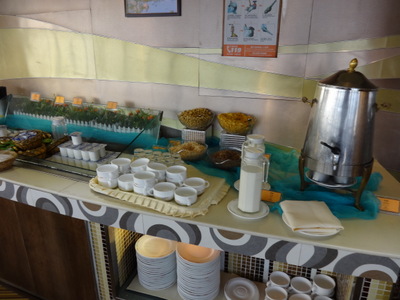
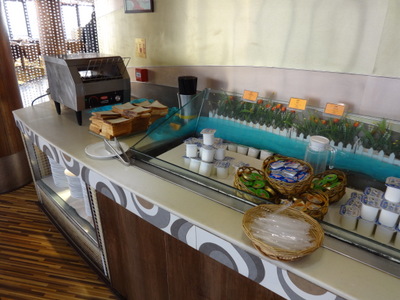 Pitchers of cold milk, hot milk, and hot soy milk. Selection of four dry breakfast cereals. Yogurt, butter (in single-serve packets from New Zealand), honey, and jam.
Pitchers of cold milk, hot milk, and hot soy milk. Selection of four dry breakfast cereals. Yogurt, butter (in single-serve packets from New Zealand), honey, and jam.
Sliced bread and a toaster. The toaster was one of those conveyer-belt types, and I guess people tended to put slices of bread in, then forget to come back for them, as there was usually a pile of toasted slices below the output slot.
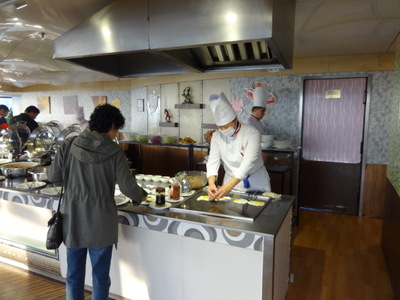
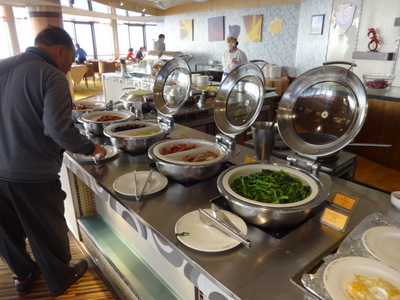 A young woman behind a flattop grill produced fried eggs, French toast, pancakes (an open box of Bisquick on the shelf behind her testified to the pancakes' authenticity), and sometimes potstickers. Bottles of soy sauce, Tabasco, and sriracha stood by for seasoning adjustment, but I saw no syrup for the pancakes. I suspect she used up the abandoned toast slices in the French toast. The fried-egg lady was particularly friendly and always seemed a little disappointed if you didn't want anything from her station. She tended to overcook the fried eggs, but if, rather than taking one from the finished stack, you watched the frying cycle and pointed to one on the griddle that she had just turned over, you could get one with a runny yolk. She talked (well, mimed) us into trying soy sauce on eggs, and we were pleasantly impressed.
A young woman behind a flattop grill produced fried eggs, French toast, pancakes (an open box of Bisquick on the shelf behind her testified to the pancakes' authenticity), and sometimes potstickers. Bottles of soy sauce, Tabasco, and sriracha stood by for seasoning adjustment, but I saw no syrup for the pancakes. I suspect she used up the abandoned toast slices in the French toast. The fried-egg lady was particularly friendly and always seemed a little disappointed if you didn't want anything from her station. She tended to overcook the fried eggs, but if, rather than taking one from the finished stack, you watched the frying cycle and pointed to one on the griddle that she had just turned over, you could get one with a runny yolk. She talked (well, mimed) us into trying soy sauce on eggs, and we were pleasantly impressed.
Beyond that were bowls of stir-fried greens (Chinese mustard? bok choy?), two kinds of link sausages, stir-fried cabbage, and cooked whole cloud ear fungus in a light sauce. A big platter of excellent American-style bacon. A bowl of boiled eggs, another of "spicy tea-cooked eggs," and a chafing dish of eggs that had been boiled, then shelled and deep fried. Lo mein and fried rice. Heaps of hot corn on the cob and whole, small steamed sweet potatoes (replaced some days with wedges of pumpkin, either steamed or roasted). A big platter of quite good tomatoey beef stew with potatoes and carrots, replaced on some days with roast chicken, hacked into slices, bones and all. A bowl of ordinary, American/British style pork and beans. A chafing dish of tofu in chicken bouillon.
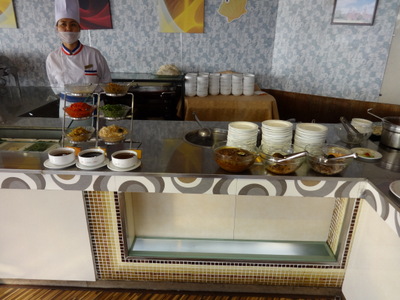
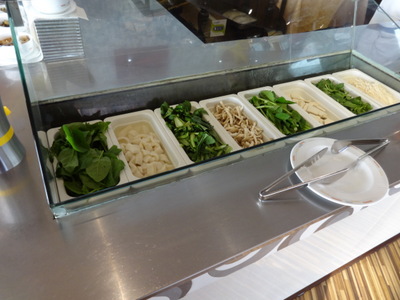 At another station a young woman presided over two deep kettles, one full of simmering soup and the other (hidden behind the piles of plates) of water at a rolling boil. The diner could either ask for a bowl of soup and then amend it with a wide array of additives (vinegar, sesame oil, chili sauce, soy sauce, tiny dried shrimp, and half a dozen more that I didn't recognize) or fill a bowl with raw stuff from an adjoining "salad bar" (spinach, bok choy, and two other kinds of greens, tofu, enoki mushrooms, Agrocybe (?) mushrooms, bamboo shoots, and, on other days, strips of fresh seaweed, chunks of chocolate colored tofu (?), mustard greens, and raw cloud ears) and hand it to her to be dumped into a mesh basket and lowered into the boiling water. When she judged the mixture done, she emptied it back into the bowl and ladeled soup over it. She would also, on request, heap hot cooked noodles into a bowl and present it to the diner for addition of the above amendments.
At another station a young woman presided over two deep kettles, one full of simmering soup and the other (hidden behind the piles of plates) of water at a rolling boil. The diner could either ask for a bowl of soup and then amend it with a wide array of additives (vinegar, sesame oil, chili sauce, soy sauce, tiny dried shrimp, and half a dozen more that I didn't recognize) or fill a bowl with raw stuff from an adjoining "salad bar" (spinach, bok choy, and two other kinds of greens, tofu, enoki mushrooms, Agrocybe (?) mushrooms, bamboo shoots, and, on other days, strips of fresh seaweed, chunks of chocolate colored tofu (?), mustard greens, and raw cloud ears) and hand it to her to be dumped into a mesh basket and lowered into the boiling water. When she judged the mixture done, she emptied it back into the bowl and ladeled soup over it. She would also, on request, heap hot cooked noodles into a bowl and present it to the diner for addition of the above amendments.
Beyond her station was a heap of tasty chewy "deep fried bread sticks," looking like giant fried pork rinds the size of your hand, and a set of half a dozen kettles filled with variations on congee (thin rice gruel, which is what I was given to understand the Chinese ordinarily eat for breakfast): ordinary white rice, black rice, millet with pumpkin, and oat, and things labeled "porridge," which looked like more congee to me. Some days, the oat variation was labeled "oatmeal," but it's what you'd get if you followed the Quaker instructions but used six cups of water rather than one. The millet and pumpkin version was very good, although in desperate need of salt.
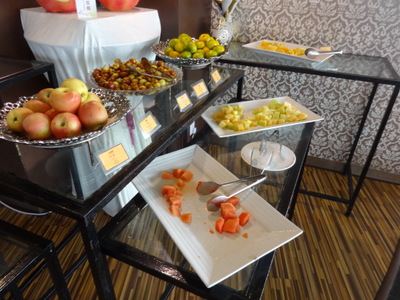
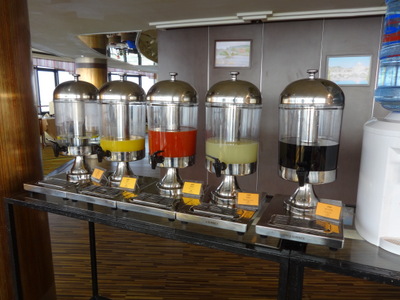 A chafing dish was full of five kinds of steamed buns (so far I've had black-rice stuffed and red-bean-paste stuffed). A fruit table offered platters of cut watermelon, canteloupe, and orange wedges, plus bowls of whole apples, tangerines, and "Chinese dates" (i.e., jujubes, Ziziphus jujuba, in the Rhamnacaeae). Those last are little green fruits the size of jumbo olives, blotched with brown, with smooth, shiny skins. I'm following the advice not to eat fruit I didn't peel myself or wash with purified water, so rather than trying them on the spot, I took a few back to the room and washed them with soap and (purified) water. Each has a single pit just like an olive or date, but the flesh and skin are strongly reminiscent of a very crisp, juicy, but tender apple. Yummy. But back to breakfast. Some days, they replaced the jujubes with apples or the canteloupe with peeled diced "dragon fruit" (i.e., the fruit of the night-blooming cereus cactus). A water cooler supplied purified water for drinking.
A chafing dish was full of five kinds of steamed buns (so far I've had black-rice stuffed and red-bean-paste stuffed). A fruit table offered platters of cut watermelon, canteloupe, and orange wedges, plus bowls of whole apples, tangerines, and "Chinese dates" (i.e., jujubes, Ziziphus jujuba, in the Rhamnacaeae). Those last are little green fruits the size of jumbo olives, blotched with brown, with smooth, shiny skins. I'm following the advice not to eat fruit I didn't peel myself or wash with purified water, so rather than trying them on the spot, I took a few back to the room and washed them with soap and (purified) water. Each has a single pit just like an olive or date, but the flesh and skin are strongly reminiscent of a very crisp, juicy, but tender apple. Yummy. But back to breakfast. Some days, they replaced the jujubes with apples or the canteloupe with peeled diced "dragon fruit" (i.e., the fruit of the night-blooming cereus cactus). A water cooler supplied purified water for drinking.
Five cylindrical juice tanks with taps at the bottom, contained water with lemon slices, orange juice, tomato juice, grapefruit juice, and Coca Cola. An 8-button coffee dispenser (buttons labeled exclusively in Chinese), a rather rickety expresso machine, a milk dispenser, two beer taps (München and Tsingtao, we haven't yet established whether those actually work during breakfast), and a six-button soft-drink dispenser. And that's just the stuff I recognized!
I was surprised at how much of the food was served at room temperature, even in chafing dishes (e.g., the beef stew, lo mein, cooked vegetables), and that, unless you count the tiny dried shrimp, not a scrap of seafood was included (well, there was an unidentified item at the soup station one day that might have been slices of cuttlefish).

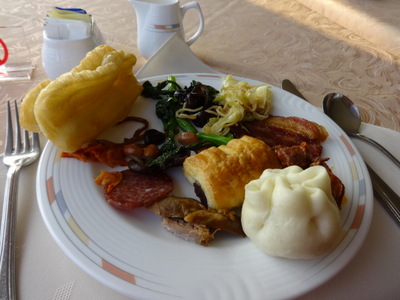 Here are our first plates on the first day.
Here are our first plates on the first day.
David, on the left, stuck with the familiar: a fried egg, bacon, a peach danish (aka "mixed broccoli"), and an odd, skinny croissant that he said was better than it looked. He branched out a little more as the week progressed, unlike a long-time colleague and friend of ours who, while devouring fried eggs, toast, sausage, and bacon smothered in pork and beans, looked with a shudder at his travel companion, who was eating a bowl of thin soup with greens and noodles, saying "I just can't imagine eating soup for breakfast!"
On my plate, at the right, the big puffy object at 11 o'clock is a deep-fried bread stick. Clockwise from there are stir-fried greens (with a few roasted peanuts on top), some lo mein with cabbage, bacon, a couple of chunks of beef stew, a big white steamed bun filled with black rice, a couple slices of smoked duck, a slice of "Italy sausage," and a dab of kim chee. The cylindrical pastry in the center is filled with sweetened red bean paste.
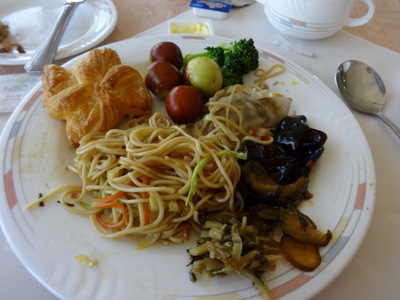 Here's another of my plates: At 12 o'clock high, four jujubes. Clockwise from there, stir-fried broccoli (not labeled "peach danish," for some reason), a pot-sticker, some cloud ears, little pickled slices that I think were cucumber, spicy chopped pickled mustard greens, and a pin-wheel-shaped unfilled Danish. In the center, cabbage lo mein, which turned out to be one of my favorite breakfast choices, especially with a little extra sesame oil drizzled over it.
Here's another of my plates: At 12 o'clock high, four jujubes. Clockwise from there, stir-fried broccoli (not labeled "peach danish," for some reason), a pot-sticker, some cloud ears, little pickled slices that I think were cucumber, spicy chopped pickled mustard greens, and a pin-wheel-shaped unfilled Danish. In the center, cabbage lo mein, which turned out to be one of my favorite breakfast choices, especially with a little extra sesame oil drizzled over it.
I was amazed at the variety of pickles, most of them just labeled "pickles." I'm pretty sure I identified cucumbers, turnip, radish, cabbage, and maybe eggplant. I had heard that the Japanese ate a lot of pickles at breakfast but that they were strong-flavored and spicy. These were mostly salt-cured and quite mild, less sour than sauerkraut, but very tasty.
The labeling did improve in the course of the week. For example, "Twinkies" was replaced by "Donuts bread," and "Mixed broccoli" by "Peach danish."
previous entry
List of Entries
next entry

 We stayed at the Huiquan Dynasty Hotel (http://www.hqdynasty.com/en/index.html), at 9 Nanhai Road in Qingdao. It's right between the No. 1 Bathing Beach (one of six numbered beaches in the city) and the Olympic plaza that tops the stadium parking structure. At the left is its main entrance, on the side facing the beach. On the right is a long shot of the whole hotel, from the Olympic plaza. It consists of a north and a south wing. Our rooms were facing the beach on the eighth floor of the south wing, which also housed the business center, indoor golf driving range, gym, mahjong rooms, "shuffleball" table, bowling lanes, hair salon, Japanese restaurant, spa, one of the pools, and (if I interpreted the sign correctly), a dentist's office.
We stayed at the Huiquan Dynasty Hotel (http://www.hqdynasty.com/en/index.html), at 9 Nanhai Road in Qingdao. It's right between the No. 1 Bathing Beach (one of six numbered beaches in the city) and the Olympic plaza that tops the stadium parking structure. At the left is its main entrance, on the side facing the beach. On the right is a long shot of the whole hotel, from the Olympic plaza. It consists of a north and a south wing. Our rooms were facing the beach on the eighth floor of the south wing, which also housed the business center, indoor golf driving range, gym, mahjong rooms, "shuffleball" table, bowling lanes, hair salon, Japanese restaurant, spa, one of the pools, and (if I interpreted the sign correctly), a dentist's office.
 The vast lobby, shown here at the left, is between the two wings and houses, besides reception, the currency exchange, bell station, "Lobby Bar," concierge's desk, and entrances to many of the shops
The vast lobby, shown here at the left, is between the two wings and houses, besides reception, the currency exchange, bell station, "Lobby Bar," concierge's desk, and entrances to many of the shops
 A rather hair-raising amenity, also neatly stowed in the closet, was a pair of these boxes, each a little larger than a child's lunchbox and containing a whole-head gas mask. My first thought was "Does the smog really get that bad?! How will we know if there's an alert?!" A quick scan of the multilingual instructions, though, revealed that they were for use in case of fire. Fair enough—a lot of the floors were above the reach of ladder trucks.
A rather hair-raising amenity, also neatly stowed in the closet, was a pair of these boxes, each a little larger than a child's lunchbox and containing a whole-head gas mask. My first thought was "Does the smog really get that bad?! How will we know if there's an alert?!" A quick scan of the multilingual instructions, though, revealed that they were for use in case of fire. Fair enough—a lot of the floors were above the reach of ladder trucks.
 Every morning, we met at breakfast. Usually, in this situation, I get up early, eat my breakfast, and wait for David in the dining room, working on the blog. This time, though, because of the jet lag, we tended to converge on the dining room together at 6:30 a.m., when it opened.
Every morning, we met at breakfast. Usually, in this situation, I get up early, eat my breakfast, and wait for David in the dining room, working on the blog. This time, though, because of the jet lag, we tended to converge on the dining room together at 6:30 a.m., when it opened.
 Next comes a station with plates of moist and tender smoked duck and chicken and "Russian style" pork. Salami (labeled "Italy sausage"), pepper loaf. Slices of a round sort of terrine, baloney colored around the edge but green in the center, labeled "spinach sausage." A small block of Swiss cheese.
Next comes a station with plates of moist and tender smoked duck and chicken and "Russian style" pork. Salami (labeled "Italy sausage"), pepper loaf. Slices of a round sort of terrine, baloney colored around the edge but green in the center, labeled "spinach sausage." A small block of Swiss cheese. 
 Pitchers of cold milk, hot milk, and hot soy milk. Selection of four dry breakfast cereals. Yogurt, butter (in single-serve packets from New Zealand), honey, and jam.
Pitchers of cold milk, hot milk, and hot soy milk. Selection of four dry breakfast cereals. Yogurt, butter (in single-serve packets from New Zealand), honey, and jam. 
 A young woman behind a flattop grill produced fried eggs, French toast, pancakes (an open box of Bisquick on the shelf behind her testified to the pancakes' authenticity), and sometimes potstickers. Bottles of soy sauce, Tabasco, and sriracha stood by for seasoning adjustment, but I saw no syrup for the pancakes. I suspect she used up the abandoned toast slices in the French toast. The fried-egg lady was particularly friendly and always seemed a little disappointed if you didn't want anything from her station. She tended to overcook the fried eggs, but if, rather than taking one from the finished stack, you watched the frying cycle and pointed to one on the griddle that she had just turned over, you could get one with a runny yolk. She talked (well, mimed) us into trying soy sauce on eggs, and we were pleasantly impressed.
A young woman behind a flattop grill produced fried eggs, French toast, pancakes (an open box of Bisquick on the shelf behind her testified to the pancakes' authenticity), and sometimes potstickers. Bottles of soy sauce, Tabasco, and sriracha stood by for seasoning adjustment, but I saw no syrup for the pancakes. I suspect she used up the abandoned toast slices in the French toast. The fried-egg lady was particularly friendly and always seemed a little disappointed if you didn't want anything from her station. She tended to overcook the fried eggs, but if, rather than taking one from the finished stack, you watched the frying cycle and pointed to one on the griddle that she had just turned over, you could get one with a runny yolk. She talked (well, mimed) us into trying soy sauce on eggs, and we were pleasantly impressed.
 At another station a young woman presided over two deep kettles, one full of simmering soup and the other (hidden behind the piles of plates) of water at a rolling boil. The diner could either ask for a bowl of soup and then amend it with a wide array of additives (vinegar, sesame oil, chili sauce, soy sauce, tiny dried shrimp, and half a dozen more that I didn't recognize) or fill a bowl with raw stuff from an adjoining "salad bar" (spinach, bok choy, and two other kinds of greens, tofu, enoki mushrooms, Agrocybe (?) mushrooms, bamboo shoots, and, on other days, strips of fresh seaweed, chunks of chocolate colored tofu (?), mustard greens, and raw cloud ears) and hand it to her to be dumped into a mesh basket and lowered into the boiling water. When she judged the mixture done, she emptied it back into the bowl and ladeled soup over it. She would also, on request, heap hot cooked noodles into a bowl and present it to the diner for addition of the above amendments.
At another station a young woman presided over two deep kettles, one full of simmering soup and the other (hidden behind the piles of plates) of water at a rolling boil. The diner could either ask for a bowl of soup and then amend it with a wide array of additives (vinegar, sesame oil, chili sauce, soy sauce, tiny dried shrimp, and half a dozen more that I didn't recognize) or fill a bowl with raw stuff from an adjoining "salad bar" (spinach, bok choy, and two other kinds of greens, tofu, enoki mushrooms, Agrocybe (?) mushrooms, bamboo shoots, and, on other days, strips of fresh seaweed, chunks of chocolate colored tofu (?), mustard greens, and raw cloud ears) and hand it to her to be dumped into a mesh basket and lowered into the boiling water. When she judged the mixture done, she emptied it back into the bowl and ladeled soup over it. She would also, on request, heap hot cooked noodles into a bowl and present it to the diner for addition of the above amendments. 
 A chafing dish was full of five kinds of steamed buns (so far I've had black-rice stuffed and red-bean-paste stuffed). A fruit table offered platters of cut watermelon, canteloupe, and orange wedges, plus bowls of whole apples, tangerines, and "Chinese dates" (i.e., jujubes, Ziziphus jujuba, in the Rhamnacaeae). Those last are little green fruits the size of jumbo olives, blotched with brown, with smooth, shiny skins. I'm following the advice not to eat fruit I didn't peel myself or wash with purified water, so rather than trying them on the spot, I took a few back to the room and washed them with soap and (purified) water. Each has a single pit just like an olive or date, but the flesh and skin are strongly reminiscent of a very crisp, juicy, but tender apple. Yummy. But back to breakfast. Some days, they replaced the jujubes with apples or the canteloupe with peeled diced "dragon fruit" (i.e., the fruit of the night-blooming cereus cactus). A water cooler supplied purified water for drinking.
A chafing dish was full of five kinds of steamed buns (so far I've had black-rice stuffed and red-bean-paste stuffed). A fruit table offered platters of cut watermelon, canteloupe, and orange wedges, plus bowls of whole apples, tangerines, and "Chinese dates" (i.e., jujubes, Ziziphus jujuba, in the Rhamnacaeae). Those last are little green fruits the size of jumbo olives, blotched with brown, with smooth, shiny skins. I'm following the advice not to eat fruit I didn't peel myself or wash with purified water, so rather than trying them on the spot, I took a few back to the room and washed them with soap and (purified) water. Each has a single pit just like an olive or date, but the flesh and skin are strongly reminiscent of a very crisp, juicy, but tender apple. Yummy. But back to breakfast. Some days, they replaced the jujubes with apples or the canteloupe with peeled diced "dragon fruit" (i.e., the fruit of the night-blooming cereus cactus). A water cooler supplied purified water for drinking. 
 Here are our first plates on the first day.
Here are our first plates on the first day.  Here's another of my plates: At 12 o'clock high, four jujubes. Clockwise from there, stir-fried broccoli (not labeled "peach danish," for some reason), a pot-sticker, some cloud ears, little pickled slices that I think were cucumber, spicy chopped pickled mustard greens, and a pin-wheel-shaped unfilled Danish. In the center, cabbage lo mein, which turned out to be one of my favorite breakfast choices, especially with a little extra sesame oil drizzled over it.
Here's another of my plates: At 12 o'clock high, four jujubes. Clockwise from there, stir-fried broccoli (not labeled "peach danish," for some reason), a pot-sticker, some cloud ears, little pickled slices that I think were cucumber, spicy chopped pickled mustard greens, and a pin-wheel-shaped unfilled Danish. In the center, cabbage lo mein, which turned out to be one of my favorite breakfast choices, especially with a little extra sesame oil drizzled over it.